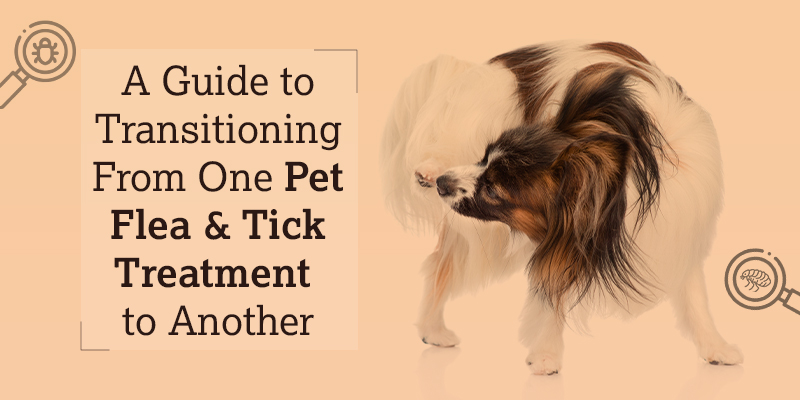
Check out our latest products
Fleas and ticks often find their way on pets due to their exposure to a contaminated environment or by contact with an infected animal. These blood-sucking creatures can cause a variety of health problems to pets, including itching & irritation, and transmitting flea/tick-borne diseases. To save your four-legged friend from the trouble, it is best to administer flea & tick treatments/preventives regularly. Sometimes, there may be a need to change the flea & tick treatment you are already using for your pet’s parasite protection for a variety of reasons. So, how to make this transition from one flea and tick treatment to another trouble-free and safe? Here we go.
Keep reading to learn about the reasons to make the change in a pet’s flea & tick treatment and a few tips to do the treatment transition the right way and make it a smooth process.
Why transition from one flea & tick treatment to another?
Here are some of the reasons why you need to transition from one flea & tick treatment to another for your pet:
Poor results
If you see fleas & ticks crawling on your fur friend, beddings, carpets or other places in the home even after the regular administration of flea & tick treatment, this means that the treatment is not working for your pet anymore. This can happen when fleas and ticks become resistant to the active ingredient in the treatment.
Side effects
Your pet may develop side effects such as vomiting, diarrhea, excessive drooling, redness of the skin, itching, scratching etc. from the flea & tick treatment you are using.
Convenience
If the topical treatment you are using is messy, does not dry quickly or is not water-resistant; it can irritate pets or lose effectiveness fast (especially when your pet loves to swim). In the case of an oral treatment, your fur baby may not like the flavor or taste of the chews or tablets. In such situations, you may need to switch to a new, more convenient-to-use flea & tick treatment.
Tips for safe transition from one flea & tick treatment to another
Consider the following points while switching from one flea & tick treatment to another to make the transition safe and convenient for your pet:
Consult a veterinarian
Your veterinarian knows your pet’s health history. They can identify the ineffectiveness of the current treatment and suggest the treatments that will work the best for your furry companion. In case you are not using the treatment appropriately, your vet can suggest the correct way of administering the dosage of the treatment suitable to your pet.
Check the active ingredients
Check the label of the new treatment thoroughly to learn about the active ingredients and ensure that your pet is not allergic to any of them. Select a treatment with a different composition than the current one to eliminate the possibility of your pet developing resistance over time. It is also better to go for the treatment that helps break the flea life cycle and inhibit the development of new infestations.
Avoid overlapping the treatments
If you are using other treatments along with your pet’s flea and tick treatment, make sure the ingredients or coverage of the new treatment do not overlap with the existing ones. Overdosing of ingredients may have an adverse impact on your pet’s health.
Prepare a transition plan
The threat of flea and tick infestations persists throughout the year and therefore, your pet’s year-round protection is necessary to ensure their safety. While you are switching to a new treatment, ensure the shift is smooth and your pet’s parasite protection is uninterrupted.
Monitor your pet & their surroundings
Once you have started with the new treatment, be observant about its performance. Monitor your pet and their surroundings closely to ensure all fleas and ticks are gone. If the problem persists or your pet develops side effects from the new treatment, check with your veterinarian again to find a more effective and suitable solution for your pet.
To conclude
Pets need year-round protection from nasty parasites like fleas and ticks. But if you find the treatment you are using ineffective, it is high time you switch to a different, more suitable treatment for your pet’s parasite protection. The tips listed in this blog will help you transition safely from one flea and tick treatment to another and keep your pet parasite-free & healthy.

David joined CanadaVetCare in 2013 as a product analyst and veterinary assistant. Being a passionate pet lover and keen animal health researcher, David had always found ways and solutions to help pet parents to improve their pets’ health. He is always happy to answer pet health-related queries and recommending pet parents for the right pet product for their furry companions.







![[5G & 2.4G] 2K Indoor Security Camera for Home Security, AI Voice Change for 2-Way Talk, Motion Detection, Night Vision, 24/7 SD Recording/Cloud Storage, WiFi Home Camera, Pet Cam with Phone App](https://i3.wp.com/m.media-amazon.com/images/I/61I2U+sTT3L._AC_SL1500_.jpg?w=300&resize=300,300&ssl=1)






